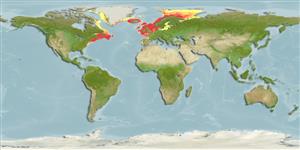Preferred temperature (Ref.
115969): 1.4 - 12.1, mean 8.4 (based on 1651 cells).
Phylogenetic diversity index (Ref.
82804): PD
50 = 1.0000 [Uniqueness, from 0.5 = low to 2.0 = high].
Bayesian length-weight: a=0.00661 (0.00584 - 0.00748), b=3.08 (3.04 - 3.12), in cm Total Length, based on LWR estimates for this species (Ref.
93245).
Trophic level (Ref.
69278): 4.0 ±0.1 se; based on diet studies.
устойчивость к внешним воздействиям (Ref.
120179): средний (среднего размера), минимальное время удвоения популяции 1.4-4.4 года (rm=0.54-1.2; K=0.12-0.30; tm=2-6.5; tmax=20; Fec=100,000).
Prior r = 0.50, 95% CL = 0.33 - 0.75, Based on 41 full stock assessments.
Fishing Vulnerability (Ref.
59153): Moderate to high vulnerability (55 of 100).
Climate Vulnerability (Ref.
125649): Moderate vulnerability (40 of 100).
